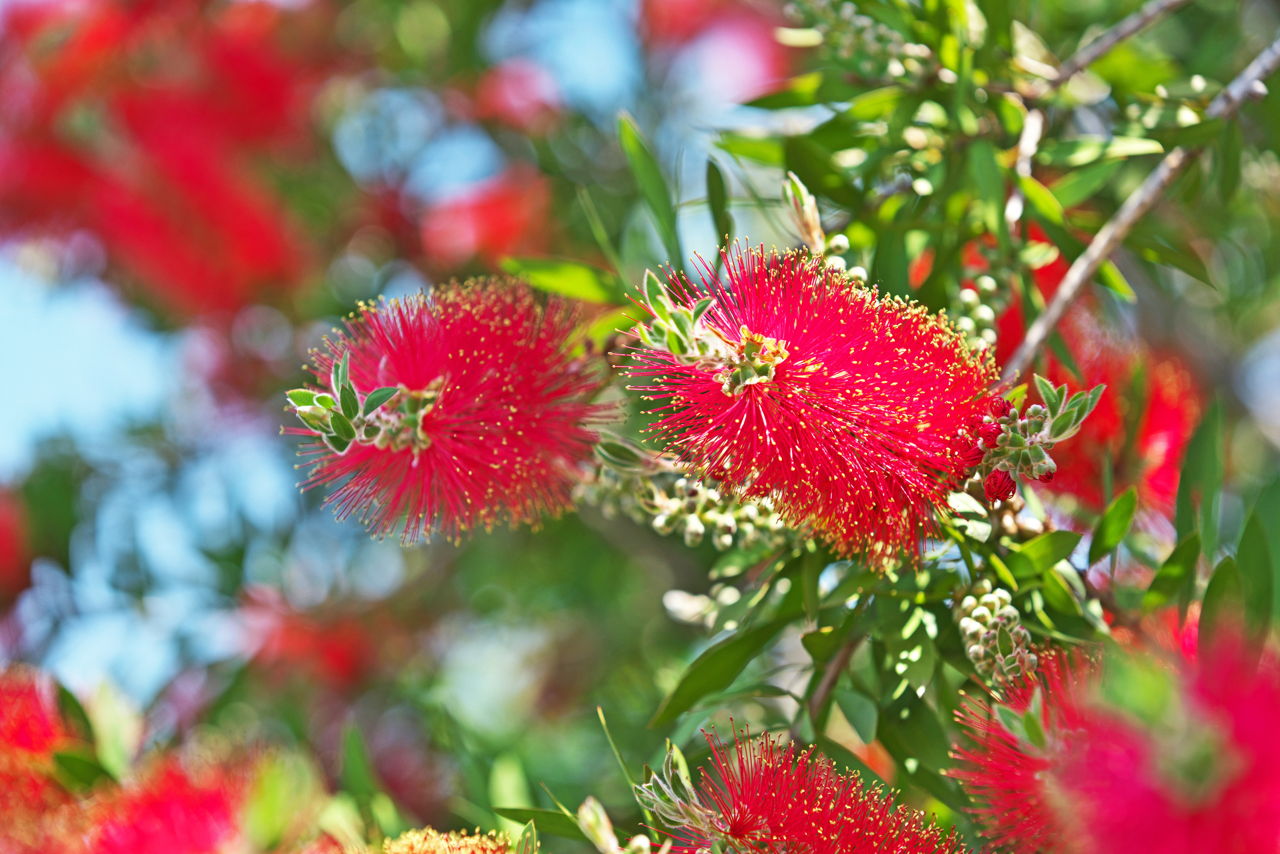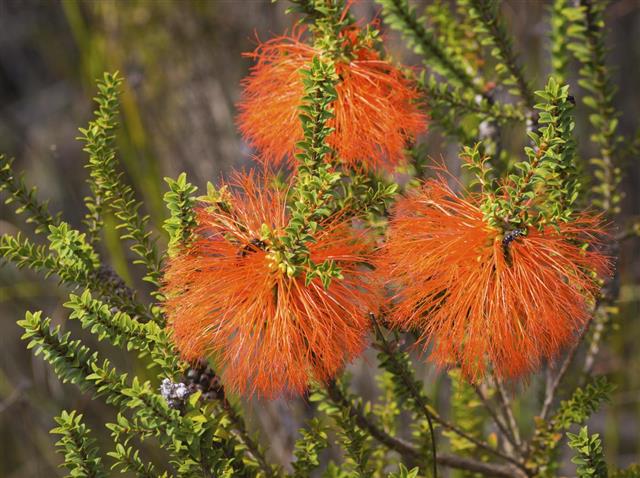
Bottlebrush trees are considerably small tress which bear deep red, and sometimes pink flowers. As is the case with every living creature, these beautiful trees too, are susceptible to a few harmful diseases and fungal infections that can kill it, or at least severely affect its life and growth. Read the following article to find out more about these diseases.
Bottlebrushes, which go by the botanical name Callistemon, can inspire artists looking for inspiration from nature. Such is their beauty. As far as trees go, they are not really big, with most varieties of bottlebrushes growing to a modest height of around 14 – 16 feet. There is a particularly adorable variety of bottlebrush that grows only up to 3 feet, and is normally used as a flowering shrub! The flowers of this tree are blood red, and when in full bloom the beauty of this tree can steal your breath. The four main species/ varieties that are commonly used, are – Dwarf Bottlebrush, Weeping Bottlebrush, Red Cluster Bottlebrush and Upright Bottlebrush. These trees flower mainly during summer and spring, but they do have some flowers throughout the year, and are not totally barren. It is necessary to care for these lovely trees to prevent them from contracting any diseases, since they are susceptible to a few.
Bottlebrush trees need just the right amount of moisture, in the soil in which they grow. Too little means that they will not grow well, whereas too much means that the soil becomes the perfect breeding ground for various fungi that attack it. This tree is more susceptible to attacks by fungi than by any other pathogens. So care has to be taken to keep the soil adequately moist as per the requirements of this tree, so that it remains disease free and lives out its life completely. The diseases that affect this evergreen tree are given below, along with some information about the preventive measures to be adopted to keep these diseases at bay.
Root Rot
Cause
Bottlebrushes grow well in moist but well drained soil. When the soil is kept too moist, or the tree is over watered, then the conditions become conducive for the fungus that causes root rot, to breed in the soil. This is a rapidly growing fungus and attacks its roots, as well as the surrounding plants. This fungus can cause dieback, and if the attack is severe, it may even kill the tree.
Symptoms
Discoloration of trunk, dieback of branches, brittle reddish brown roots, leaves turning yellow, and premature defoliation.
Prevention/ Control
Applying fungicides may help, but this disease is very difficult to treat once the fungus has attacked the tree. So to prevent this disease, ensure that the soil is kept adequately moist, not wet and soggy all the time.
Leaf Blotch/ Leaf Spot
Cause
This is a fungal disease that spreads due to the water being too soggy. It affects the beauty and appearance of the tree, and although it does not kill it, the tree looks infected and ill.
Symptoms
Premature defoliation is a good indication that the bottlebrush may be suffering from leaf spot, but since this symptom can also be confused with root rot disease, the other, more telling symptom to look out for, is spots on its leaves. These spots are small when they begin to show, but they increase rapidly in size. They are brown in the center, with a yellowish border around it.
Prevention/ Control
When the leaves fall off, there is still fungus on them, so instead of letting them stay where they fall, it is advisable to rake them and burn them off. This will help prevent the fungus from re-attacking the tree. Spray the tree with liquid copper fungicide. Keep the soil slightly moist instead of wet, and do not over water the tree.
Verticillium Wilt
Cause
All bottlebrush buckeye trees can be hit by this fungal disease. The fungus that is responsible for this disease, breeds in the soil and attacks the wood. This disease is notorious for killing other plants if the attack is severe, but strangely, the bottlebrush is spared this fate. At the most, this disease succeeds in killing a few branches of this tree.
Symptoms
Yellowing or discoloration of the leaves, along with early defoliation.
Prevention/ Control
This fungus is very resilient towards fungicides, so even after the soil has been properly and thoroughly sprayed with the fungicide, this fungus will still stay alive. The affected branches should be cut off, and sterilized or sprayed with fungicides. Even this is no guarantee that the tree is safe from this fungus, since it is still present in the soil. So the safest bet, is to uproot the tree and move it to another place, where the soil is healthy.
Twig Gall
Cause
Sphaeropsis tumefaciens is the pathogen that causes this fungal disease. It loves attacking the bottlebrush, since this tree is ‘woody’. Warm and moist conditions aid the breeding of this fungus, hence, soggy soil around this tree will cause an attack of twig gall.
Symptoms
In this disease, an abnormally large number of shoots spring from the tree, and the branches of the bottlebrush seem to bloat and become bulky. Over time, these symptoms exaggerate and severely harm the tree.
Prevention/ Control
This disease can be prevented, by not allowing the soil in which the tree is growing, to be soggy and water logged. Cut off the swollen branches of the bottlebrush immediately after the symptoms become visible, to stop the fungus from spreading to other parts or plants that it comes in contact with. After cutting off the swollen and unhealthy branches, make sure to sterilize them, in order to destroy the fungus present on them. Fertilize the tree as and when required, to prevent re-occurrence.
Powdery Mildew
Cause
Incorrect watering practice causes this disease. When the tree is watered from above, it causes the water to collect on the leaves. The fungus that causes this disease breeds in such collected water. Even rainwater collecting on the leaves after a shower, will cause this fungus to breed. This disease does not kill the tree, but it does affect the blooming of the tree, making it look dull and unattractive.
Symptoms
Powdered mildew has the appearance of a fine whitish powder, in keeping with its name. This powder appears on the leaves of the tree. Early defoliation, withered buds, discolored or yellowed leaves, are symptoms of this disease.
Prevention/ Control
Let your tree remain as dry as possible. Plant it where it receives plenty of sunlight, and where it is not cluttered or closely surrounded by other plants. Spray it with fungicide, and allow the tree to breathe. Mainly, do not water the tree from the top.
Cankers
Cause
Fungus is the cause of this disease too, since this tree is extremely susceptible to fungal infections. Once again, the cause is extremely wet and soggy soil, and improper fertilization. This disease spreads very rapidly, gravely affecting the growth of the tree. Bottlebrushes affected by this disease suffer stunted growth, and look dead and lifeless. If the infection is grave, the tree will eventually die.
Symptoms
The tree becomes disfigured, and the branches become uneven, with pits and swollen areas. This is visible on the branches, and more so on the trunk of the bottlebrush.
Prevention/ Control
Regular and timely fertilization, and proper spraying of the tree with fungicides, should help prevent this disease from affecting the tree. As mentioned earlier, make sure the soil is not too wet. As soon as the symptoms start showing, cut off the affected areas, and spray them with fungicides and sterilize them.
From all the above prevention techniques, it must be pretty clear by now, that the bottlebrush tree cannot tolerate extremely wet and soggy soil. If taken care of properly, this tree can add a lot of beauty to any garden or backyard. Maintaining this tree is actually not a herculean task. It requires fertilization approximately 4 times a year. This tree is often short lived because of its susceptibility to fungal diseases and infections, but proper maintenance will let you enjoy its blooms all year round.
